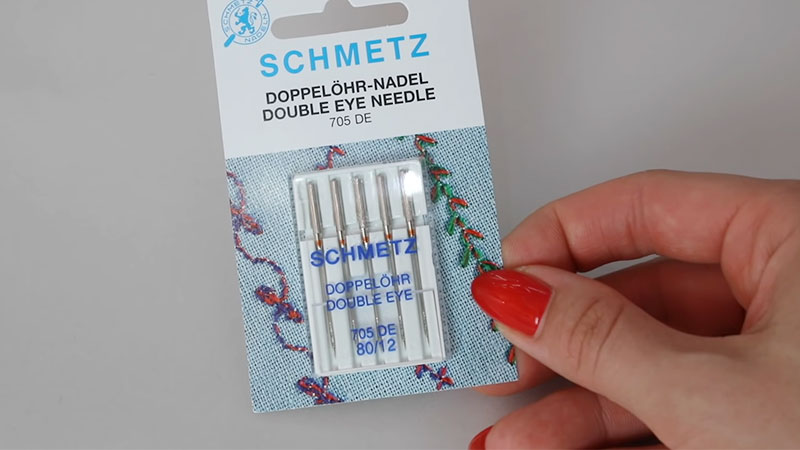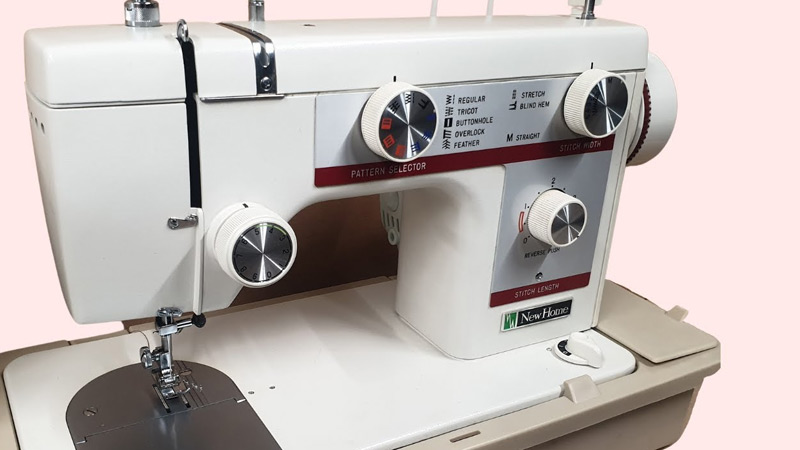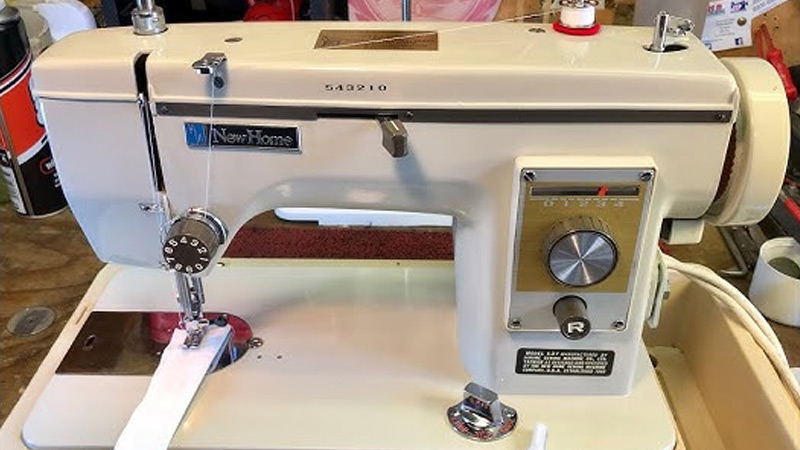Sewing enthusiasts often find themselves captivated by the versatility and precision of the New Home 23L Sewing Machine.
Whether you’re a novice or an experienced seamstress, this dependable machine can handle a wide range of sewing projects with finesse.
However, to unlock its full potential, you must pay attention to one crucial detail: the needles you use.
The right needles can make all the difference in your sewing experience, affecting the quality of your stitches and the overall success of your projects.
In this guide, we will delve into the essential details of selecting the appropriate needles for your New Home 23L Sewing Machine, ensuring that every stitch is a masterpiece.

Suitable Needles for New Home 23L Sewing Machines
The New Home 23L Sewing Machine is a versatile and reliable sewing machine that can tackle various sewing projects. To ensure that it performs at its best, it’s essential to use the right needles.
Choosing the suitable needles for your New Home 23L is crucial to achieving excellent stitching results.
Here are some key factors to consider when selecting new home sewing machine needles:
Needle System
The New Home 23L Sewing Machine uses standard home sewing machine needles, typically with a 15×1 or HAx1 system.
It’s essential to ensure that the needles you choose match this system for compatibility with your machine.
Needle Sizes
The appropriate needle size depends on the type of fabric you plan to sew and the thickness of the thread you intend to use.
Common needle sizes for the New Home 23L range from 70/10 for lightweight fabrics to 100/16 for heavier materials.
Smaller sizes work well with delicate fabrics, while larger sizes are suitable for thicker fabrics like denim or upholstery materials.
Needle Types
Different sewing projects require different needle types.
Here are some common needle types suitable for the New Home 23L:
- Universal Needles: These are versatile and suitable for a wide range of fabrics, making them a good choice for general sewing.
- Ballpoint Needles: Ideal for knit and stretch fabrics as they have a rounded tip that slides between fabric fibers without causing snags.
- Stretch Needles: Designed for highly elastic and stretchy fabrics like spandex and Lycra.
- Denim Needles: Best for sewing through heavyweight denim and canvas.
- Quilting Needles: These have a tapered point for quilting and piecing.
- Leather Needles: Used for sewing leather and faux leather materials.
Needle Maintenance
Regularly inspect your needles for any signs of wear or damage. Bent or dull needles can cause stitching problems.
Replace the needle after 8-10 hours of sewing or if you notice issues like skipped stitches, puckering, or uneven stitching.
Thread Compatibility
Ensure that the needle size and type are compatible with the thread you intend to use. Using the wrong needle-thread combination can lead to sewing issues.
New Home Sewing Machine 1990

The New Home Sewing Machine from the 1990s represents a significant era in the history of sewing machines, characterized by advancements in technology and design.
During this period, sewing machines were transitioning from mechanical to computerized models, offering a range of features to enhance sewing capabilities.
Here are some key aspects of New Home Sewing Machines from the 1990s:
Computerization
In the 1990s, New Home Sewing Machines embraced computerization. These machines featured electronic displays and buttons, providing convenient access to various stitches, stitch lengths, and other settings.
This transition to computerization brought greater precision and user-friendliness to sewing.
Stitch Variety
New Home machines from this era offered a diverse range of built-in stitches. These included essential utility stitches, decorative patterns, and even embroidery-style designs.
The abundance of stitch options made these machines versatile for a wide array of sewing projects.
Automatic Features
Many 1990s New Home sewing machines came equipped with automatic features. Automatic needle threading simplified the threading process, while automatic buttonholers ensured consistent and precise buttonhole creation.
Memory Functions
Certain models featured memory functions, allowing users to program and save custom stitch patterns or embroidery designs.
This feature was especially beneficial for those seeking to explore creative and personalized sewing projects.
Speed Control
Adjustable speed control was a common feature in New Home machines of this era. Users could set the sewing speed to their preferred level, enhancing control and comfort during sewing.
Quilting and Embroidery Capabilities
Some New Home models were designed with quilting and embroidery features. These machines excelled in handling quilting layers and delivering precise embroidery stitching, making them suitable for intricate design work.
Durability and Build Quality
New Home sewing machines maintained their reputation for durability and robust construction. This heritage of quality ensured that these machines could withstand heavy usage and continue to perform reliably.
Manuals and Documentation
New Home provided comprehensive user manuals and documentation for their sewing machines.
These resources were invaluable for users, offering guidance on understanding the machines’ features and functions.
Availability and Collectibility
Even today, New Home sewing machines from the 1990s can be found in the secondhand market.
Many sewing enthusiasts appreciate these machines for their durability and unique features, contributing to their continued collectibility and use in creative projects.
New Home Sewing Machine Company

The New Home Sewing Machine Company, also known as the New Home Sewing Machine Company of Orange, Massachusetts, was a prominent sewing machine manufacturer with a rich history in the United States.
Here is an overview of the company:
Founding and Early Years
The New Home Sewing Machine Company was established in 1860 in Orange, Massachusetts, by John P. Clark and James Barker.
Initially known as Clark & Barker, the company rebranded itself in 1867 as the New Home Sewing Machine Company, coinciding with the introduction of their first sewing machine, the “New Home.”
Sewing Machine Innovations
New Home quickly gained a reputation for producing high-quality sewing machines, celebrated for their durability and innovative features.
The company became a pioneer in introducing improvements and innovations to sewing machine technology, contributing significantly to the sewing industry’s growth.
Expansion and Success
The company’s sewing machines gained widespread popularity among households and seamstresses due to their reliability and user-friendliness.
Over time, the company diversified its product line, offering a wide range of sewing machines, from basic models for home use to advanced machines capable of embroidery and decorative stitching.
Mergers and Acquisitions
In 1882, the New Home Sewing Machine Company merged with the “National Sewing Machine Company,” forming the “National-Davis Sewing Machine Company.”
Subsequently, the company underwent several mergers and acquisitions, resulting in various brand names associated with its sewing machines, including “Free,” “Morse,” and “Janome.”
Legacy
Despite changes in ownership and brand names, New Home sewing machines continued to be celebrated for their quality and longevity.
The Janome Corporation, originating in Japan, eventually became the parent company of New Home sewing machines.
The Janome brand remains a leading name in the sewing machine industry, recognized for its commitment to producing reliable and innovative machines.
FAQS
Can I use twin needles with the New Home 23L Sewing Machine?
Yes, you can use twin needles with the New Home 23L.
What type of needle is best for sewing silk fabric on the New Home 23L?
When sewing delicate silk fabrics on the New Home 23L, it’s advisable to use a fine needle, such as a size 70/10 or 80/12, to prevent snagging or damaging the material.
Can I use metallic thread with this sewing machine, and what needle should I use for it?
Yes, you can use metallic thread with the New Home 23L.
What needle should I choose for sewing faux leather or vinyl materials with the New Home 23L?
When working with faux leather or vinyl materials, opt for a leather needle. Leather needles are designed to pierce through these thick and tough fabrics with ease.
Do I need to change the needle when switching between different fabric types in one project on the New Home 23L?
It’s advisable to change the needle when transitioning between different fabric types within a single project.
To Recap
Selecting the right needles for your New Home 23L Sewing Machine is a pivotal step in ensuring sewing success.
The choice of needles, encompassing size, type, and quality, directly influences the outcome of your projects.
Whether you’re working with delicate silks, robust denims, or stretchy knits, the appropriate needle can make the difference between frustration and satisfaction.
By referring to the machine’s manual, considering the fabric and thread you’re using, and understanding the nuances of various needle types, you can unlock the full potential of your New Home 23L.
Armed with this knowledge, you’ll embark on your sewing journeys with confidence, producing impeccable stitches and exquisite creations.
Leave a Reply